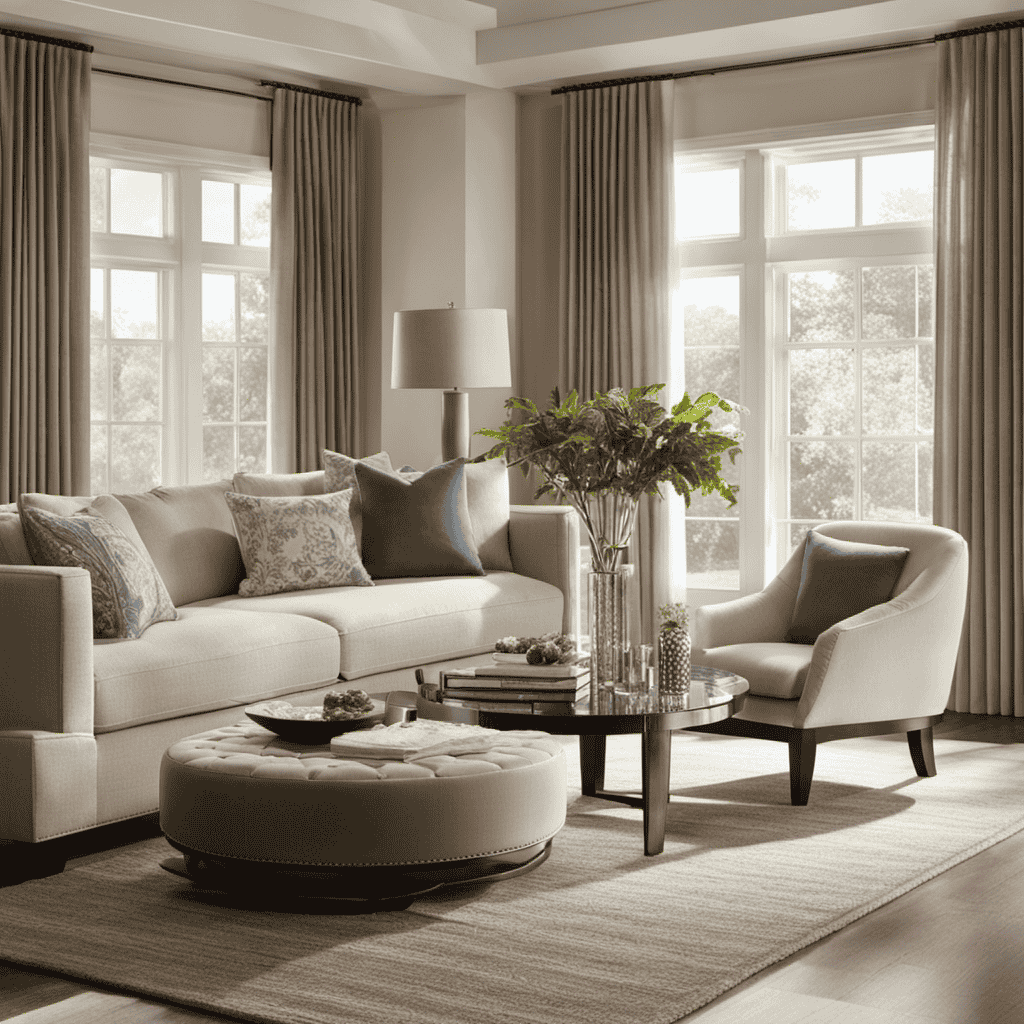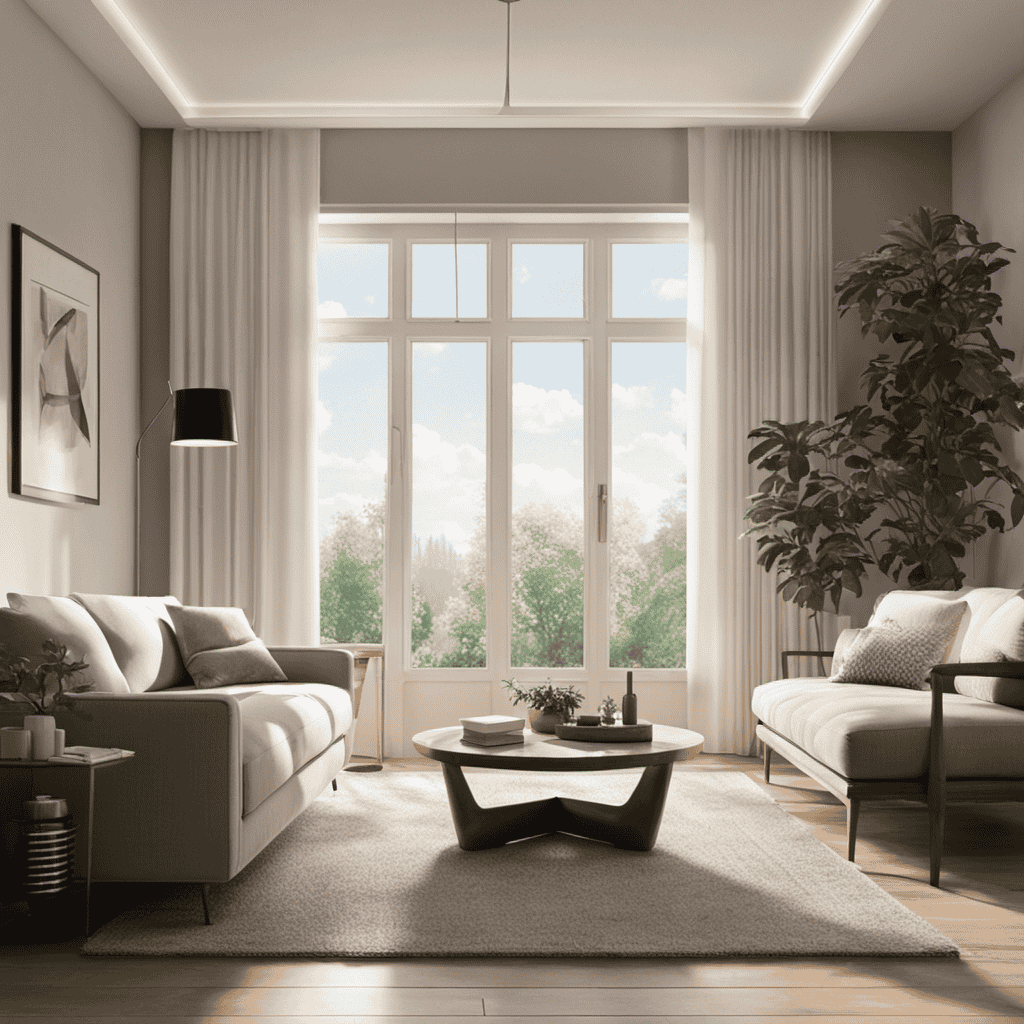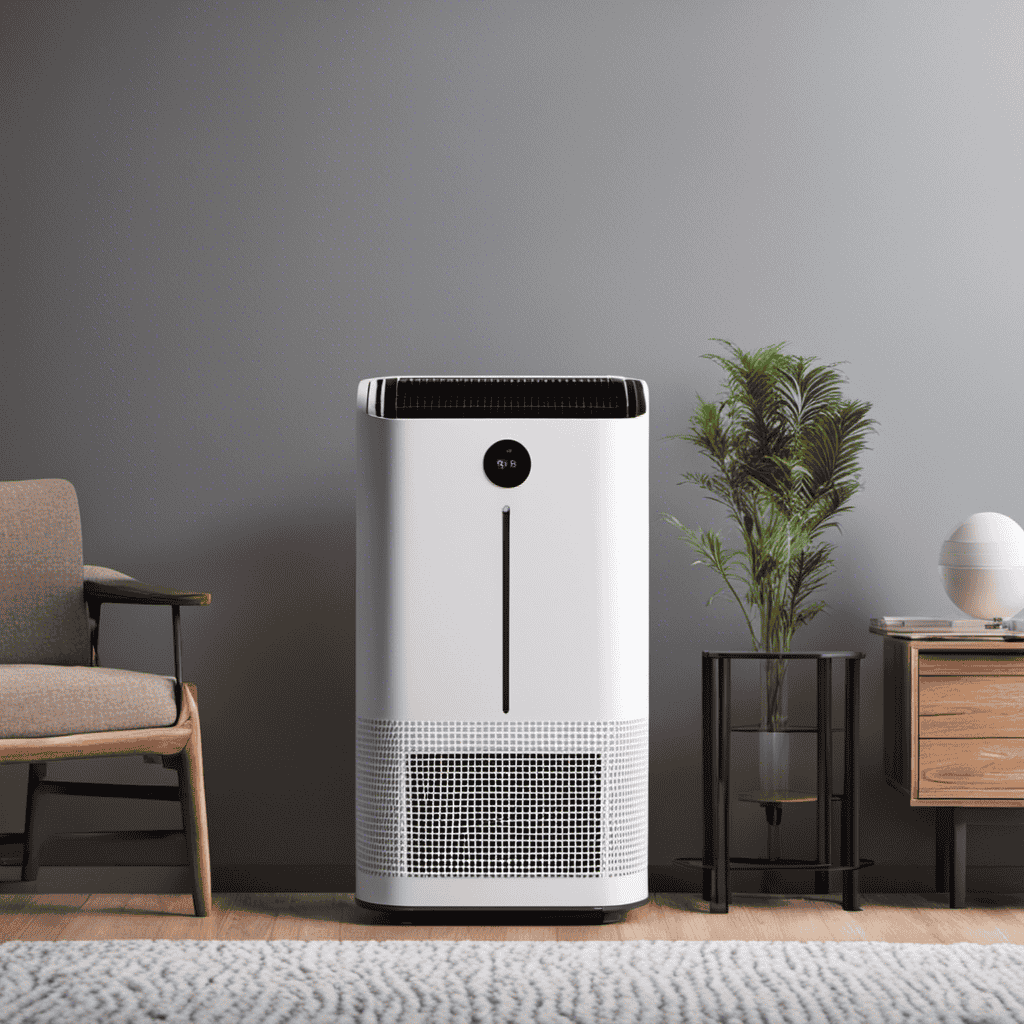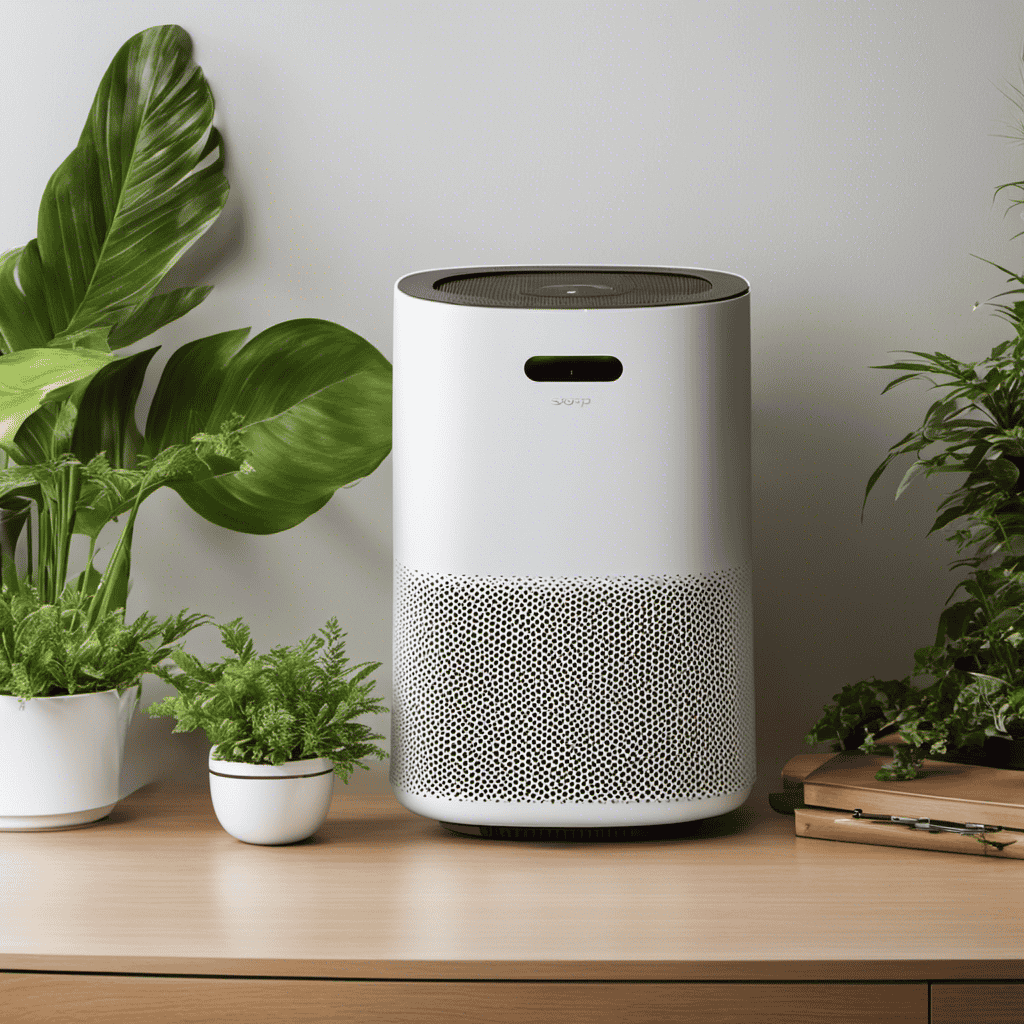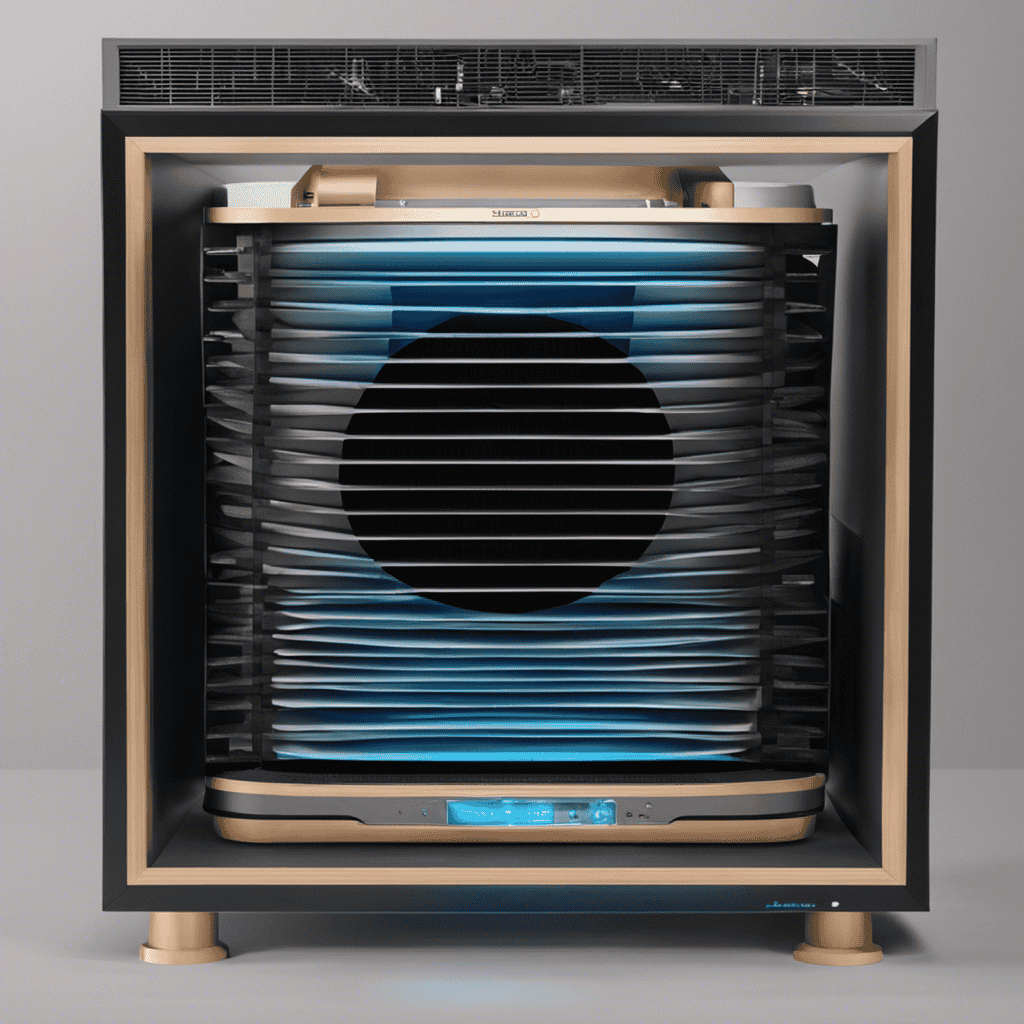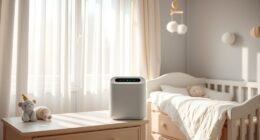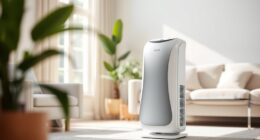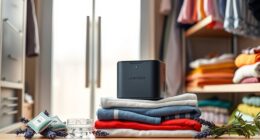So, are you curious about what an air purifier is? Allow me to explain it to you.
An air purifier is a nifty device that can improve the quality of the air in your surroundings by removing nasty pollutants. It’s like having a personal guardian angel for your lungs!
In this article, I’ll delve into the different types of air purifiers, how they work their magic, and the benefits of having one in your life. Trust me, you won’t want to miss this.
Key Takeaways
- Air purifiers come in different types and brands, such as Honeywell, Dyson, and Blueair.
- The air purification process involves multiple stages, including pre-filtration, HEPA filtration, activated carbon filtration, and UV-C light treatment.
- Air purifiers can effectively remove dust, pollen, pet dander, mold spores, smoke particles, and VOCs, resulting in improved indoor air quality and reduced allergies and asthma symptoms.
- Regular maintenance, including cleaning or replacing filters, cleaning the exterior, and ensuring proper airflow, is necessary for optimal performance and longevity of the air purifier.
Types of Air Purifiers
There are a few different types of air purifiers on the market. Some popular brands include Honeywell, Dyson, and Blueair. Each brand offers various models with different features to cater to different needs.
Air purifiers require regular maintenance to ensure optimal performance. This includes cleaning or replacing the filters, which are designed to capture and remove airborne particles. Some air purifiers have indicator lights to remind you when it’s time to clean or change the filters.
Additionally, it’s important to regularly clean the exterior of the air purifier to prevent the buildup of dust and other contaminants. Following the manufacturer’s instructions for maintenance is crucial to keep your air purifier functioning effectively and prolong its lifespan.
How Air Purifiers Work
As we delve into the topic of how air purifiers work, it is important to understand the air purification process, the common pollutants that can be removed, and the benefits of using these devices.
The air purification process typically involves multiple stages, such as pre-filtration, HEPA filtration, activated carbon filtration, and sometimes even UV-C light treatment.
Common pollutants that can be effectively removed by air purifiers include dust, pollen, pet dander, mold spores, smoke particles, and volatile organic compounds (VOCs).
Using an air purifier can lead to improved indoor air quality, reduced allergies and asthma symptoms, elimination of unpleasant odors, and a healthier living environment overall.
Air Purification Process
The air purifier uses filters to remove particles and pollutants from the air. Air purification technologies play a crucial role in maintaining the indoor air quality, which is of utmost importance for our health and well-being. These technologies employ various methods to eliminate contaminants and improve air quality. One common method is the use of mechanical filters, such as HEPA filters, which trap particles as small as 0.3 microns. Another effective technique is activated carbon filtration, which absorbs odors, chemicals, and gases. Additionally, there are air purifiers that utilize UV-C light to kill bacteria and viruses. It is essential to understand the significance of indoor air quality and invest in air purification systems to create a healthier and safer living environment.
| Air Purification Technologies | Importance of Indoor Air Quality |
|---|---|
| Mechanical Filters (HEPA) | Reduces allergens and pollutants |
| Activated Carbon Filtration | Eliminates odors and chemicals |
| UV-C Light | Kills bacteria and viruses |
| Ionizers and Ozone Generators | Removes airborne particles |
Common Pollutants Removed
Common pollutants, such as dust, pollen, and pet dander, can be effectively removed by air purification technologies. These pollutants, often invisible to the naked eye, can have detrimental effects on health and overall well-being.
Dust particles, for instance, contain various allergens and irritants that can trigger respiratory conditions like asthma and allergies. Pollen, another common pollutant, can cause allergic reactions and worsen symptoms in individuals with hay fever. Additionally, pet dander, which consists of tiny flakes of skin shed by animals, can aggravate allergies and respiratory issues.
Benefits of Using
Using an air purifier can greatly improve indoor air quality and help create a healthier environment. Air purifier technology has advanced significantly in recent years, allowing for more effective removal of airborne pollutants and allergens. The benefits of using an air purifier extend beyond just cleaner air. Studies have shown that air purifiers can reduce the risk of respiratory diseases such as asthma and allergies. They can also help eliminate odors and harmful chemicals, creating a more pleasant living space. Additionally, air purifiers can improve sleep quality by removing airborne particles that can disrupt sleep. Investing in an air purifier is a wise choice for anyone concerned about their health and well-being.
| Benefit | Description |
|---|---|
| Cleaner air | Removes pollutants such as dust, pollen, pet dander, and mold spores |
| Health protection | Reduces the risk of respiratory diseases and allergies |
| Improved sleep | Removes airborne particles that can disrupt sleep |
Benefits of Using an Air Purifier
You’ll love the benefits of having an air purifier in your home. Air purifiers are designed to improve indoor air quality by removing harmful pollutants and allergens from the air.
These devices work by using filters or other technologies to capture and trap particles such as dust, pollen, pet dander, and mold spores. By removing these pollutants, air purifiers can help reduce allergies, asthma symptoms, and respiratory issues.
Additionally, air purifiers can also eliminate unpleasant odors and neutralize harmful chemicals, such as volatile organic compounds (VOCs), which are commonly found in cleaning products and furniture.
With an air purifier, you can enjoy cleaner and fresher air in your home, creating a healthier living environment for you and your family.
Now, let’s explore some common air pollutants and how they can affect your health.
Common Air Pollutants
One of the most frequent air pollutants found in homes is dust, which can cause respiratory issues and allergies. Dust particles can contain a variety of harmful substances such as pet dander, pollen, mold spores, and chemicals. These pollutants can have detrimental effects on our health, leading to symptoms like coughing, wheezing, congestion, and even asthma attacks.
Air pollution causes a range of health effects, including both short-term and long-term impacts. Short-term effects can include irritation of the eyes, nose, and throat, as well as headaches and dizziness. Long-term exposure to air pollution can result in chronic respiratory diseases, cardiovascular problems, and even premature death.
To combat the harmful effects of air pollutants, using an air purifier can be highly beneficial. An air purifier works by filtering out airborne particles and contaminants, improving the overall air quality in your home. This can help reduce the risk of respiratory issues and allergies caused by air pollution.
Factors to Consider When Choosing an Air Purifier
When choosing an air purifier, it’s important to consider factors such as the size of your room and the specific pollutants you want to target. The size of your room determines the capacity of the air purifier you need. If your room is larger, you will require a higher Clean Air Delivery Rate (CADR) to effectively purify the air. Additionally, you should consider the type of pollutants you want to remove. Different air purifiers are designed to target specific pollutants such as dust, pollen, pet dander, smoke, or odors. To help you make an informed decision, here is a table summarizing the factors and considerations when choosing an air purifier:
| Factors | Considerations |
|---|---|
| Room Size | Determine the appropriate CADR for your room size. |
| Pollutants | Identify the specific pollutants you want to target. |
| Filter Type | Choose the right filter technology for your needs. |
| Noise Level | Consider the noise level of the air purifier. |
| Maintenance | Evaluate the ease of filter replacement and overall maintenance. |
Considering these factors will ensure you select an air purifier that best suits your needs and provides clean and healthy air for you and your family.
Understanding Air Purifier Filters
Understanding the different types of filters is crucial when selecting the right air purifier for your needs. The type of filter used in an air purifier determines its efficiency in removing pollutants from the air. Here are three common types of filters:
-
HEPA (High-Efficiency Particulate Air) filters: These filters are highly effective in capturing microscopic particles such as dust, pollen, pet dander, and mold spores. They can remove up to 99.97% of particles as small as 0.3 microns.
-
Activated carbon filters: These filters are excellent at adsorbing odors, gases, and chemicals. They work by trapping these substances in their porous surface, providing cleaner and fresher air.
-
Pre-filters: These filters capture larger particles like dust and hair, preventing them from clogging the main filter and prolonging its lifespan.
Regular air purifier maintenance is essential to ensure optimal performance. This includes replacing filters according to the manufacturer’s recommendations and cleaning the unit regularly.
Air Purifier Placement Tips
Placing your air purifier in a central location can help maximize its effectiveness in cleaning the air.
When it comes to air purifier positioning, there are a few important factors to consider in order to optimize air purification.
Firstly, it’s crucial to place the purifier in a location where it can circulate air efficiently. This means avoiding obstructed areas such as behind furniture or in corners.
Additionally, it’s recommended to position the purifier at least a few feet away from walls to allow for proper airflow.
Another important consideration is the height at which the purifier is placed. It’s ideal to position it at a height that’s roughly chest level, as this allows for better air intake.
The Role of HEPA Filters in Air Purifiers
To maximize the effectiveness of your air purifier, make sure to regularly replace the HEPA filters.
HEPA filters play a crucial role in capturing and removing harmful particles from the air.
Here are three key points to consider:
-
HEPA filter efficiency: HEPA filters are designed to remove 99.97% of particles as small as 0.3 microns. This high level of efficiency ensures that the air you breathe is cleaner and free from allergens, dust, pollen, and other pollutants.
-
Regular replacement: Over time, HEPA filters become clogged with captured particles, reducing their effectiveness. It is recommended to replace the filters every 6 to 12 months, depending on the air quality and usage of your air purifier.
-
Improved indoor air quality: By regularly replacing the HEPA filters, you can maintain the optimal performance of your air purifier and ensure that it continues to provide clean and healthy air for you and your family.
Air Purifiers Vs. Humidifiers: What’s the Difference
When comparing air purifiers and humidifiers, it is important to understand their purpose and function, as well as their effects on air quality.
Air purifiers are designed to remove pollutants and contaminants from the air, such as dust, pollen, and pet dander, improving the overall air quality.
On the other hand, humidifiers are used to add moisture to the air, which can help alleviate dryness and respiratory issues caused by low humidity.
Both devices have different functions and can have varying effects on air quality, so it is crucial to understand their differences before making a decision.
Purpose & Function
You can understand the purpose and function of an air purifier by learning about its ability to remove airborne contaminants from your indoor environment. Air purifiers are designed to improve indoor air quality by capturing and eliminating pollutants such as dust, pollen, pet dander, mold spores, and even harmful gases.
Here are some key benefits of using an air purifier:
- Reduction of allergens: Air purifiers can significantly reduce the presence of allergens in your home, providing relief to allergy sufferers.
- Improved respiratory health: By removing airborne particles and pollutants, air purifiers can help improve respiratory conditions and reduce the risk of respiratory infections.
- Odor elimination: Air purifiers with activated carbon filters can effectively eliminate unpleasant odors, such as those from cooking, pets, or smoke.
To ensure optimal performance, regular maintenance of your air purifier is essential. This includes cleaning or replacing filters, checking for any malfunctions, and keeping the unit in a clean environment. Regular maintenance can prolong the lifespan of your air purifier and ensure that it continues to provide clean and fresh indoor air.
Effects on Air Quality
One important factor to consider is the effectiveness of the filters in capturing and removing pollutants from your indoor environment. Air purifiers play a crucial role in improving air quality by eliminating harmful particles and contaminants. The advancement in air purifier technology has led to the development of highly efficient filters that can effectively capture even the smallest pollutants. These filters are designed to target specific pollutants such as dust, pollen, pet dander, mold spores, and even volatile organic compounds (VOCs). By removing these pollutants, air purifiers provide numerous benefits, including reducing allergies and respiratory issues, eliminating unpleasant odors, and creating a healthier living environment. Here is a table showcasing the different types of filters commonly used in air purifiers:
| Filter Type | Description | Effectiveness |
|---|---|---|
| HEPA | High-Efficiency Particulate Air filters that can capture particles as small as 0.3 microns. | Highly effective in removing dust, pollen, pet dander, and other large particles. |
| Activated Carbon | Absorbs and traps odors, chemicals, and gases. | Effective in eliminating unpleasant smells, smoke, and VOCs. |
| UV-C | Ultraviolet-C light that kills bacteria, viruses, and mold spores. | Destroys harmful microorganisms, improving overall air quality. |
Investing in an air purifier with advanced filter technology can greatly enhance the air quality in your home or office, providing a range of health benefits and a cleaner living space.
Air Purifiers for Allergies and Asthma
If you suffer from allergies or asthma, an air purifier can help alleviate your symptoms. Air purifiers are designed to improve indoor air quality by removing harmful particles and pollutants from the air. They work by drawing in air, filtering it through a series of filters, and then releasing clean air back into the room.
Here are three ways air purifiers can benefit those with respiratory health issues:
-
Reduction of allergens: Air purifiers can effectively capture and remove common allergens such as pollen, pet dander, and dust mites, which can trigger allergies and asthma attacks.
-
Removal of indoor pollutants: Indoor pollutants like volatile organic compounds (VOCs), smoke, and mold spores can be harmful to respiratory health. Air purifiers can help eliminate these pollutants, promoting a healthier indoor environment.
-
Improved air circulation: Air purifiers can help improve air circulation in a room, which can prevent the buildup of stagnant air and reduce the concentration of respiratory irritants.
Investing in an air purifier can significantly contribute to better respiratory health and provide relief for those with allergies and asthma.
Air Purifiers for Pet Owners
As a pet owner, I’ve often struggled with pet allergens in my home. That’s why I started researching pet-friendly air purifiers that can effectively eliminate pet allergens from the air.
These specialized air purifiers are designed with innovative features and filters that specifically target pet dander, hair, and odors. They ensure a clean and allergen-free environment for both me and my furry friends.
Pet-Friendly Air Purifiers
When choosing an air purifier for your home, you’ll want to consider pet-friendly options. These purifiers are specifically designed to effectively remove pet dander, hair, and odors from the air, ensuring a clean and fresh environment for both you and your furry friend.
Here are three reasons why pet-friendly air purifiers are a great choice:
-
Powerful filtration: Pet-friendly air purifiers are equipped with advanced filtration systems that can capture even the smallest particles, including pet allergens, bacteria, and viruses.
-
Quiet operation: These purifiers are designed to operate silently, creating a peaceful environment for you and your pet.
-
Compact size: Air purifiers for small spaces are perfect for placing in pet-friendly areas such as baby nurseries. They are compact and portable, making them easy to move around as needed.
Eliminating Pet Allergens
To eliminate pet allergens, you should regularly clean and vacuum your furniture and floors.
Pet dander, which is composed of tiny flecks of skin, is a common allergen that can trigger respiratory reactions in sensitive individuals.
Cleaning your furniture and floors helps to remove pet dander from the environment, reducing the chances of an allergic reaction.
When cleaning, make sure to use a vacuum cleaner with a HEPA filter, as it is specifically designed to capture small particles like pet dander.
HEPA filters are capable of trapping 99.97% of airborne particles, including pet hair, dust mites, and pollen.
This ensures that the air in your home is clean and free from pet allergens.
Regular cleaning and vacuuming, along with the use of a HEPA filter, are key steps in creating a pet-friendly environment for allergy sufferers.
Air Purifiers for Smokers
If you’re a smoker, consider using an air purifier to reduce the amount of smoke and odor in your home. Air purifiers are designed to filter out harmful particles and chemicals from the air, providing cleaner and healthier indoor air quality.
When it comes to air purifiers for smokers, there are a few key features to look for:
- High-efficiency particulate air (HEPA) filters: These filters can trap small particles, such as smoke and tobacco odors, ensuring that the air in your home is free from these pollutants.
- Activated carbon filters: These filters are effective in removing odors and chemicals, providing fresher air.
- Coverage area: Consider the size of the room or area where you will be using the air purifier to ensure that it can effectively clean the air.
Additionally, if you smoke in your car, there are air purifiers specifically designed for cars that can help eliminate smoke and odors. These portable purifiers can be easily installed and provide fresh and clean air while driving.
Air Purifiers for Odor Control
When it comes to dealing with odors in indoor spaces, it is crucial to have effective odor elimination techniques and reliable air purification systems.
Odor elimination techniques can include various methods such as activated carbon filters, ozone generators, and UV light sanitization. These techniques work by trapping or neutralizing odor-causing particles and molecules, ensuring that the air is clean and fresh.
Effective air purification systems, on the other hand, utilize advanced filtration technologies to remove not only odors but also pollutants, allergens, and other harmful particles from the air, providing a healthier and more comfortable living environment.
Odor Elimination Techniques
Using activated carbon filters is an effective way to eliminate odors in an air purifier. These filters are designed to trap and remove volatile organic compounds (VOCs) and other odorous substances from the air. When air passes through the carbon filter, the activated carbon adsorbs the odors, leaving the air fresh and clean.
To ensure optimal odor elimination, it is important to follow best practices in air purifier technology. Regularly replace the activated carbon filters to maintain their effectiveness. Keep the air purifier running continuously to continuously filter and eliminate odors. Place the air purifier in strategic locations to maximize air circulation and odor elimination.
Effective Air Purification
Regularly replacing the activated carbon filters in your air purifier will help ensure effective odor elimination. Air purifiers use various technologies to purify the air, including activated carbon filters. These filters are designed to trap and adsorb odorous particles and pollutants, effectively removing them from the air.
When choosing the right air purifier, it is important to consider the size of the space you need to clean, the specific pollutants you want to eliminate, and the technology used in the air purifier. Different technologies, such as HEPA filters, UV-C light, and ionizers, target different types of pollutants and allergens. By understanding the air purifier technologies and selecting the appropriate one for your needs, you can maximize the effectiveness of odor elimination and air purification in your space.
Transitioning into the next section about maintenance and cleaning of air purifiers, it is crucial to properly maintain and clean your air purifier to ensure its long-term performance and efficiency.
Maintenance and Cleaning of Air Purifiers
To keep your air purifier functioning effectively, it’s important to regularly clean and maintain it. Here are some maintenance tips and cleaning techniques to ensure optimal performance:
- Change the filters regularly to remove dust, allergens, and pollutants from the air.
- Clean the exterior of the purifier with a soft cloth and mild detergent to remove dirt and grime.
- Vacuum the vents and intake grills to prevent clogging and maximize airflow.
Regular maintenance not only improves the air quality in your home but also extends the lifespan of your air purifier. By following these cleaning techniques, you can ensure that your air purifier continues to provide you with clean and fresh air.
Now, let’s move on to some tips for maximizing the effectiveness of your air purifier.
Tips for Maximizing the Effectiveness of Your Air Purifier
Now that we know how to properly maintain and clean our air purifiers, let’s discuss some tips for maximizing their effectiveness in improving indoor air quality.
| Tips for Maximizing Air Purifier Effectiveness | |
|---|---|
| 1. Placement | Place the air purifier in a central location, away from obstructions, to ensure maximum air circulation. |
| 2. Regular Filter Replacement | Follow the manufacturer’s instructions for filter replacement to keep your air purifier functioning at its best. |
| 3. Clean Surrounding Areas | Regularly clean the surrounding areas to minimize dust and dirt buildup, which can affect the performance of the air purifier. |
Frequently Asked Questions
Can Air Purifiers Help Reduce the Spread of Viruses and Bacteria?
Yes, air purifiers can help reduce the spread of viruses and bacteria. They are effective at filtering out airborne pathogens, which can help improve indoor air quality and reduce the risk of allergies and respiratory infections.
Are Air Purifiers Safe to Use Around Children and Pets?
Yes, air purifiers are safe to use around children and pets. However, it is important to maintain them properly and be aware of potential health risks associated with inhaling pollutants trapped in the filters.
How Often Should the Filters of an Air Purifier Be Replaced?
I replace the filters in my air purifier every 3-6 months to maintain its effectiveness. Signs that indicate filter replacement include reduced airflow, increased dust accumulation, and a decrease in the purifier’s overall performance.
Can Air Purifiers Eliminate Cooking Odors?
Yes, air purifiers can effectively eliminate cooking odors by filtering out volatile organic compounds (VOCs) and other airborne particles. They can also reduce tobacco smoke and pet dander, improving indoor air quality.
Can Air Purifiers Help With Sleep Quality?
Yes, air purifiers can help improve sleep quality by reducing indoor pollutants such as dust, pet dander, and pollen. They can also be effective in reducing allergies, allowing for a cleaner and healthier sleep environment.
Conclusion
In conclusion, an air purifier is an essential tool in maintaining clean and healthy indoor air. By removing harmful particles and pollutants, it ensures a safer environment for you and your loved ones.
Just like a knight in shining armor, an air purifier fights against invisible enemies, defending your home from allergens, smoke, and odors.
With regular maintenance and proper usage, this trusty companion will continue to provide you with fresh and pure air, allowing you to breathe easy and live a healthier life.
So, invest in an air purifier today and let it be your guardian against air pollution.
